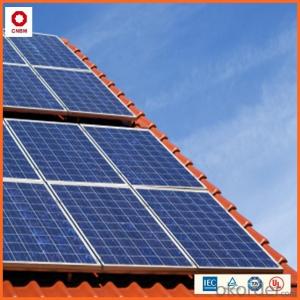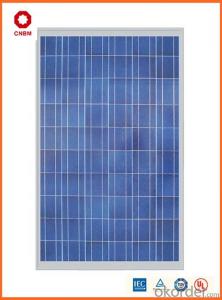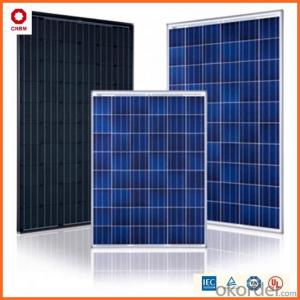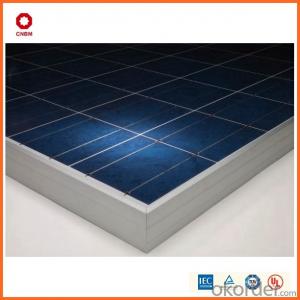35w Small Solar Panels in Stock China Manufacturer
- Loading Port:
- China main port
- Payment Terms:
- TT OR LC
- Min Order Qty:
- 1 watt
- Supply Capability:
- 10000000 watt/month
OKorder Service Pledge
OKorder Financial Service
You Might Also Like
Item specifice
Product Description:
Hot Sale !!! Quality and Safety of Small Poly Solar Panel 5w~150w
1. Rigorous quality control meets the highest international standards.
2. High-transmissivity low-iron tempered glass, strong aluminium frame.
3. Using UV-resistant silicon.
4. IS09001/14001/CE/TUV/UL
Warranties of Small Poly Solar Panel 35~85w
1. 10 years limited product warranty
2. 15 years at 90% of the minimal rated power output
3. 25 years at 80% of the minimal rated power output
Specification
Characteristics of Poly solar panels CNBM (245-320W) | |||||
Max Power Voltage Vmp(V) | 30.3 | 30.8 | 31.1 | 31.4 | 31.85 |
Max Power Current Imp(A) | 7.60 | 7.64 | 7.73 | 7.81 | 7.85 |
Open Circuit Voltage Voc(V) | 36.1 | 36.6 | 37 | 37.3 | 37.68 |
Short Circuit Current Isc(A) | 8.50 | 8.55 | 8.65 | 8.75 | 8.85 |
Max Power Pm(W) | 230W | 235W | 240W | 245W | 250W |
Temperature Coefficient of Cells Poly solar panels CNBM (245-320W) | |
NOCT | 45± 2 |
Temperature Coeffucients of Isc | 0.0492 |
Temperature Coeffucients of Voc | -0.3374 |
Temperature Coeffucients of Voc | -0.4677 |
Mechanical Data of Poly solar panels CNBM (245-320W) | |
Dimension | 1638 × 982 × 40 mm |
Weight | 19.5 kg |
No. of Cells and Connections | 60 (6 ×10) |
Tolerance | 0 ~ + 5 W |
Cell | Monocrystalline Cell 156 × 156 mm |
Packing | 624 Pcs/40ft(H) Container |
Limits of Poly solar panels CNBM (245-320W) | |
Operating Temperature | -40 to +85 |
Storage Temperature | -40 to +85 |
Max System Voltage | 1000VDC(IEC) / 600VDC(UL) |
Features of our products:
• High conversion efficiency mono/poly-crystalline amorphous silicon solar cells
• Modules incorporate high performance bypass diodes to minimize the power drop caused by shading
• High transmittance, low-iron tempered glass
• High performance EVA encapsulant to prevent destroying and water.
• AI frame: without screw, corner connection. 8 holes on the frame can be installed easily
• Good performance of preventing from atrocious weather such as wind and hails
• Certifications: CE IEC TUV VDE UL, Class I
• 10 years 90% power output warranty

Shipping of Small Poly Solar Panel 35~85w
By Sea | Delivery from Shanghai or Ningbo seaport |
By Air | Departure from Shanghai Pudong Airport |
By Express | Post by DHL, EMS, UPS, TNT. |
Features of our products:
• High conversion efficiency mono/poly-crystalline amorphous silicon solar cells
• Modules incorporate high performance bypass diodes to minimize the power drop caused by shading
• High transmittance, low-iron tempered glass
• High performance EVA encapsulant to prevent destroying and water.
• AI frame: without screw, corner connection. 8 holes on the frame can be installed easily
• Good performance of preventing from atrocious weather such as wind and hails
• Certifications: CE IEC TUV VDE UL, Class I
• 10 years 90% power output warranty
As a professional Solar Panel manufacturer and Supplier in China, we have our customers come around the whole world and our specialization has got a worldwide recognition. Meanwhile, with our superior quality, competitive price, prompt and excellent service, As main role in trade section of CNBM Group, CNBM International Corporation supplies products including Monocrystalline Solar Panel, Polycrystalline Solar Panel ( multicrystalline silicon Solar Panel) have received and enjoyed famous reputation in many countries and regions in the world.
- Q:How does the performance of solar panels degrade over time?
- The performance of solar panels degrades over time due to various factors such as exposure to sunlight, temperature fluctuations, and environmental conditions. These factors can cause the panels to degrade gradually, resulting in a decrease in their efficiency and power output. Additionally, the accumulation of dirt, dust, and debris can also impact the performance of solar panels over time. Regular maintenance and cleaning can help mitigate this degradation and ensure optimal performance.
- Q:Can solar energy systems be used in remote locations?
- Yes, solar energy systems can be used in remote locations. Unlike traditional power sources, solar energy systems do not require a direct connection to the electricity grid. They can operate independently by harnessing the power of sunlight and converting it into usable electricity. This makes solar energy systems a viable and efficient option for powering remote locations where grid access is limited or non-existent.
- Q:How does the cost of solar energy compare to other energy sources?
- Over the past few years, solar energy has become increasingly cost competitive with other forms of energy. In the beginning, solar panels were more expensive due to high installation costs and limited efficiency compared to fossil fuels. However, advancements in technology, economies of scale, and supportive government policies have significantly reduced the cost of solar energy. Currently, solar energy is rapidly becoming more affordable and competitive. In many areas, it is already cheaper than coal and natural gas, which used to be the most cost-effective energy sources. This trend is expected to continue as solar technology improves and becomes more efficient. One of the main reasons for the decrease in solar energy costs is the falling prices of solar panels. Over time, the prices of photovoltaic (PV) modules, the key component of solar panels, have significantly dropped. Additionally, the manufacturing process has become more streamlined and efficient, resulting in cost savings. Moreover, the operational costs of solar energy are relatively low because sunlight, the primary fuel source, is abundant and free. Compared to fossil fuel-based power plants, solar energy systems require less maintenance and have a longer lifespan, leading to lower operating costs in the long run. Government incentives and policies have also played a crucial role in reducing the cost of solar energy. Many countries and regions offer financial incentives, tax credits, grants, and subsidies to encourage the use of solar energy. These initiatives make solar installations more affordable for consumers and incentivize investment in solar technology, driving economies of scale and further reducing costs. In conclusion, the cost of solar energy has become highly competitive with other energy sources due to technological advancements, economies of scale, and supportive government policies. As solar energy becomes more affordable, it is expected to play a significant role in the global energy transition, offering a clean, sustainable, and cost-effective alternative to traditional energy sources.
- Q:How does the performance of solar panels vary based on the altitude?
- Solar panel performance can be influenced by altitude due to various factors. One of the main factors is the amount of sunlight that reaches the panels. As altitude increases, the panels receive more direct sunlight because the atmosphere becomes thinner. This leads to enhanced efficiency and power output. Furthermore, solar panels tend to perform better at higher altitudes due to lower temperatures. Lower temperatures allow the panels to operate more efficiently, as excessive heat can reduce their efficiency. Thus, the cooler temperatures found at higher altitudes help maintain the panels' optimal operating temperature, resulting in improved performance. However, altitude can also have negative effects on solar panel performance. Higher altitudes may experience increased snowfall or ice formation, which can obstruct sunlight and decrease panel efficiency. Additionally, extreme weather conditions like high winds or hailstorms, which are more common at higher altitudes, can potentially damage the panels and impact their performance. It is important to consider that the impact of altitude on solar panel performance may vary depending on specific geographical locations and local climate conditions. Therefore, it is advisable to take these factors into account, seek expert guidance, or conduct thorough research when installing solar panels at different altitudes to maximize their performance.
- Q:Can solar energy systems be used for powering electric vehicle component manufacturing plants?
- Certainly, electric vehicle component manufacturing plants can make use of solar energy systems. Solar power is an abundant and sustainable source of electricity that can effectively meet the energy requirements of various industrial processes. By installing solar panels on the roofs or open areas surrounding the manufacturing facility, the plant can produce clean and emission-free electricity, reducing its dependence on conventional energy sources. Solar energy systems have the capacity to generate a significant amount of electricity, particularly when combined with advanced technologies like concentrated solar power or solar tracking systems. These systems efficiently capture sunlight and convert it into electricity, providing a reliable and consistent power source for the manufacturing plant. Furthermore, electric vehicle component manufacturing plants often consume substantial energy for activities such as machining, welding, and assembly. By utilizing solar power, these plants can not only fulfill their electricity needs but also lower their operational expenses and environmental impact. Solar energy contributes to achieving sustainability objectives and facilitates a cleaner and more eco-friendly manufacturing process. Moreover, the adoption of solar energy systems in electric vehicle component manufacturing plants can serve as an effective marketing tool. As the demand for electric vehicles and sustainable manufacturing practices continues to grow, consumers are increasingly attracted to companies that actively promote renewable energy. By powering their manufacturing plants with solar energy, companies can demonstrate their commitment to environmental responsibility and appeal to environmentally conscious customers. In conclusion, solar energy systems can indeed be employed to power electric vehicle component manufacturing plants. With their ability to generate clean, reliable, and cost-effective electricity, solar power plays a crucial role in meeting the energy requirements of these plants while promoting sustainability and reducing environmental impact.
- Q:Can solar energy systems be used in areas with high levels of seismic activity?
- Yes, solar energy systems can be used in areas with high levels of seismic activity. However, it is important to design and install these systems with proper engineering considerations and precautions to withstand potential earthquakes. By implementing robust mounting structures, flexible connections, and secure anchoring systems, solar panels can be made resilient to seismic forces. Additionally, regular inspections and maintenance should be carried out to ensure the integrity and safety of the solar energy systems in earthquake-prone areas.
- Q:What permits are required to install a solar energy system?
- The permits needed for installing a solar energy system can differ based on the location and specific regulations of the area. Nevertheless, there are typically a few common permits that most jurisdictions require. To begin with, the installation of solar panels or any structural modifications usually necessitates a building permit. This permit guarantees that the system is installed safely and adheres to the building codes and regulations of the area. Furthermore, an electrical permit is often mandatory because the installation of a solar energy system involves connecting electrical components. This permit ensures that a licensed electrician carries out the electrical work and meets the electrical safety standards of the area. In some cases, additional permits or approvals may also be required by certain jurisdictions. For example, a zoning permit may be necessary to ensure that the installation complies with local zoning laws and does not violate any height restrictions or setback requirements. It is important to keep in mind that permit requirements and procedures can vary significantly. Therefore, it is always advisable to consult the local authorities or building department to determine the specific permits needed for installing a solar energy system in a particular area. Collaborating with a reputable solar installer or contractor can also be beneficial as they are generally familiar with the local permit requirements and can assist in obtaining the necessary permits.
- Q:Can solar energy systems be used for powering communication systems?
- Yes, solar energy systems can be used to power communication systems. Solar panels can convert sunlight into electricity, which can then be utilized to operate various communication devices such as cell phones, radios, satellite phones, and even entire communication networks in remote areas. This makes solar energy an environmentally friendly and sustainable option for powering communication systems.
- Q:What is a solar thermal system?
- A solar thermal system is a technology that uses sunlight to heat water or other fluids for various applications such as heating buildings, providing hot water, or generating electricity. It involves capturing solar energy using collectors, typically mounted on rooftops, and transferring it to a storage tank or heat exchanger where it can be used or converted into usable energy.
- Q:How do solar energy systems impact energy access in developing countries?
- Solar energy systems have a significant positive impact on energy access in developing countries. These systems provide a clean and sustainable source of electricity that is often more affordable and reliable than traditional fossil fuel-based options. By harnessing the abundant sunlight, solar power enables communities to gain access to electricity in remote areas where grid infrastructure is limited. This improves the quality of life by powering homes, schools, and healthcare facilities, while also stimulating economic growth and reducing carbon emissions. Overall, solar energy systems play a crucial role in expanding energy access and promoting sustainable development in developing countries.
1. Manufacturer Overview |
|
|---|---|
| Location | |
| Year Established | |
| Annual Output Value | |
| Main Markets | |
| Company Certifications | |
2. Manufacturer Certificates |
|
|---|---|
| a) Certification Name | |
| Range | |
| Reference | |
| Validity Period | |
3. Manufacturer Capability |
|
|---|---|
| a)Trade Capacity | |
| Nearest Port | |
| Export Percentage | |
| No.of Employees in Trade Department | |
| Language Spoken: | |
| b)Factory Information | |
| Factory Size: | |
| No. of Production Lines | |
| Contract Manufacturing | |
| Product Price Range | |
Send your message to us
35w Small Solar Panels in Stock China Manufacturer
- Loading Port:
- China main port
- Payment Terms:
- TT OR LC
- Min Order Qty:
- 1 watt
- Supply Capability:
- 10000000 watt/month
OKorder Service Pledge
OKorder Financial Service
Similar products
New products
Hot products
Hot Searches
Related keywords































